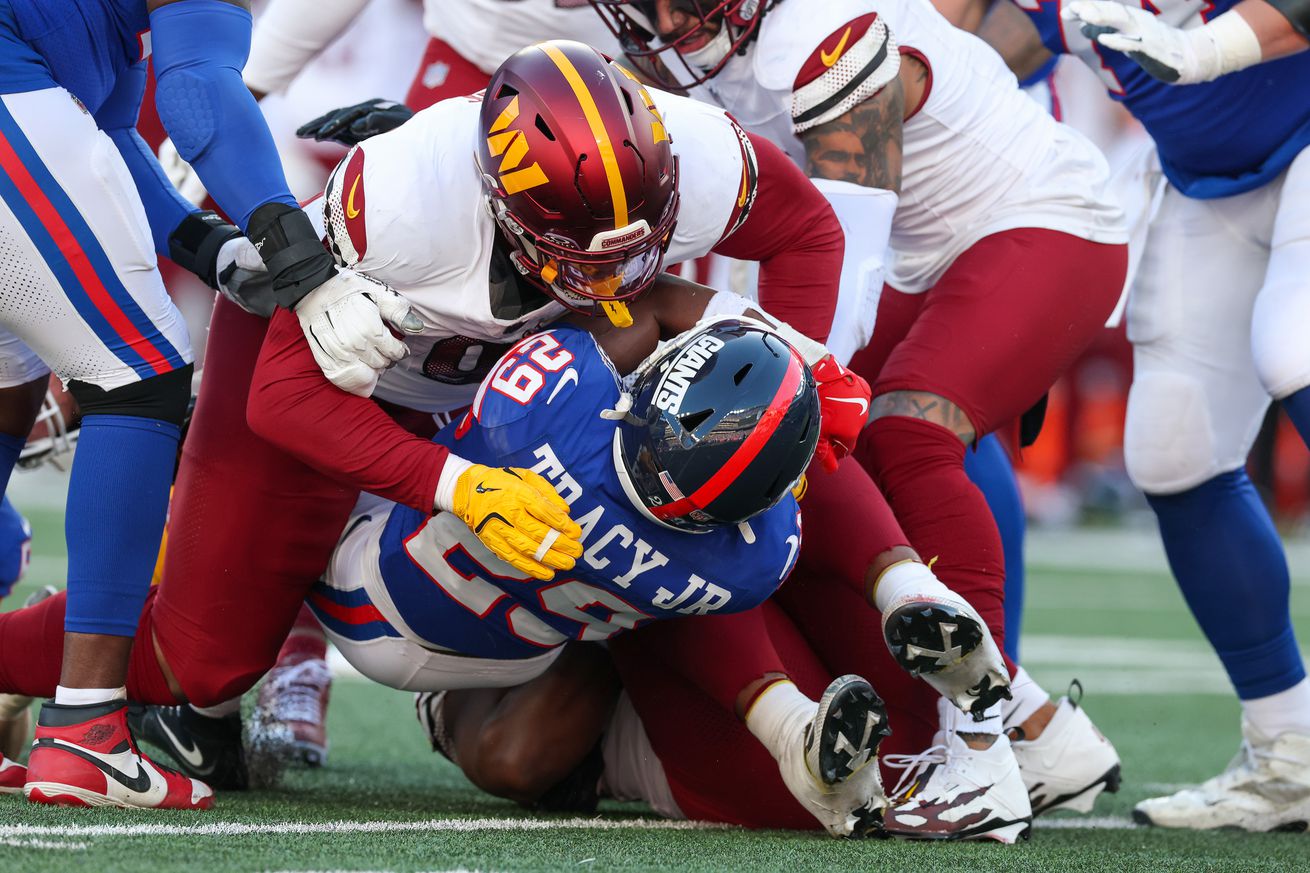
Examining the weakest part of Washington’s unexpectedly strong game: Part 3 of 4
As training camp gets underway, anticipation is building to see how the offseason additions and departures might translate to improved play on the field. The defense was the weakest part of the Commanders’ game in the first year of the Peters/Quinn rebuild. So it was no surprise that it received focused attention in free agency and the draft. The DL saw the most activity of any position group in free agency, providing some indication of the urgency the team felt about bolstering the trenches.
Key questions in fans minds, as we start to follow reports from camp, are whether the new additions can replace the production of departing starters Jon Allen and Dante Fowler, whether the run defense will improve, or are they just treading water or even going backward?
This four part series is examining the Commanders’ DL play in 2024, to understand the key weaknesses that needed to improve. The first two articles in the series focussed exclusively on run defense, which was Washington’s worst vulnerability in 2024. However, the pass defense was not actually as strong as the total yardage allowed figure might lead you to believe. Efficiency metrics, which correct for differences in numbers of attempts, showed the passing defense to be closer to middle of the pack or slightly below average.
This article will therefore extend the analysis to include the pass rush, while maintaining the emphasis on the run defense.
The first article revealed a key weakness in defending runs around the left end (right end of the DL), which opponents exploited for disproportionate yardage gains. The run defense was particularly strong on the opposite end. Run defense on the interior was mediocre, overall, with the left side of the DL being stronger than the right side.
The second article examined where individual players line up and how that related to the strengths and weaknesses in run defense. The results point toward DE Dorance Armstrong and DT Daron Payne as likely being the strongest run defenders on the DL, and to DE Clelin Ferrell as possibly being the weak link in the starting lineup.
However, this type of coarse correlational approach has a huge amount of slop to it, and doesn’t take into account other likely contributing factors, such as defensive scheme, and the role of linebackers. Also, the DL is highly rotational. With the lone exception of Clelin Ferrel at RDE, no player manned the same position on the field for more than 50% of defensive snaps, making it challenging to isolate individual player contributions. Consequently the findings are, at best, only indicative of possible strengths and weaknesses.
To get a firmer handle on how things might change on the DL, this article takes a look at the past performance of the Commanders’ returning, departing and new interior defensive linemen at stopping the run and rushing the passer. The final article concludes the series by taking a similar look at the edge defenders.
Ranking Commanders’ 2024 Player Performance
I used two metrics to rank the performance of the Commanders’ iDL against the rest of the league: Run Stop Rate and Pressure Rate. For veteran players, I also plotted time series to put their 2024 performances in the context of their entire careers.
Run Stop Rate
Defensive linemen contribute to run defense in two ways. They can set up other defenders to make plays by clogging gaps and setting the edge. And they can get off blocks to stop the ball carrier. There aren’t any stats to measure space eating and edge setting. So I focussed on making plays on the ball carrier to quantify performance in run defense. It might just be half of the picture, but it’s an important half.
Run Stops are a PFF Signature Stat. A Stop occurs when a defender makes a tackle that causes the offensive play to fail. It is defined relative to down and distance to gain. On first down, it is a tackle short of 40% of the yards to gain. On second down it is a tackle short of 50% of the yards to gain. And on third down or fourth down it is a tackle that prevents a conversion or a score.
Run Stops are a much more informative metric of defensive performance than tackle counts, which don’t differentiate between plays on which a defender stopped the offense short and those on which he arrived late and allowed a big gain.
For example, in 2023, Commanders linebacker Cody Barton made the 25th most tackles among NFL linebackers, placing him in the top half of starters at the position. He only ranked 61st in total defensive Stops, placing him close to the bottom of NFL starters (assuming 2 starters per team). Commanders fans who had the displeasure of watching Barton make late tackles after big games will appreciate that Stops counts provide a better picture of his defensive performance than raw tackle counts.
In this article, I used Run Stop Rate (Stops as a percentage of running plays) to permit fair comparison between players with different amounts of playing time. Barton ranked 77th among LBs in Run Stop Rate (min 94 snaps, regular season).
Pressure Rate
Pressure rate is simply the percentage of pass rush snaps on which a defender recorded a pressure (QB hurry, QB hit, sack). I used Pressure Rate instead of Sack Rate to measure pass rush performance for two reasons. Pressures measure all the ways that defenders influence the QB. They also occur more frequently than just sacks, and therefore provide larger sample sizes for more reliable statistical analyses. All but the very best defenders produce fewer than one sack per game. As a rule of thumb, it is better to measure performance based on events that happen multiple times per game than those that occur less than once per game. The latter are subject to variability and flukiness associated with small samples.
What the Numbers Mean
Since these are less familiar stats, the following reference ranges are provided to help readers understand what the numbers mean. The sample is the 80 iDL with the most playing time, representing the league’s starters, more or less.
2024 iDL Run Stop Rates
Max: 12.4%, DaVon Hamilton, Jaguars
Top 10%: 10.0%, Kobie Turner, Rams
Top Quartile: 8% Nnamdi Madubuike, Ravens
Median: 6.5%
Bottom Quartile: 5.3%
Min: 1.8%
2024 iDL Pressure Rates
Max: 13.7%, John Franklin-Myers, Broncos
Top 10%: 12.0%, Quinnen Williams, Jets
Top Quartile: 10.5%, Vita Vea, Buccaneers
Median: 7.9%
Bottom Quartile: 6.1%
Min: 2.0%
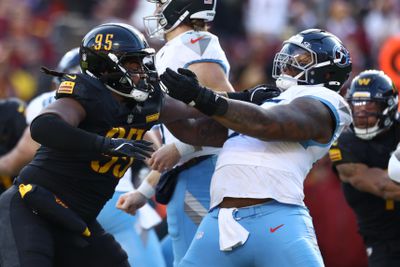
Photo by Timothy Nwachukwu/Getty Images
How Did the Commanders iDL Stack Up? – Starters
The Commanders’ iDL were ranked by Run Stop Rate among 153 players who played at least 76 run defense snaps (20% of the maximum snaps). Pressure Rate rankings were among 120 players with at least 142 pass rush snaps (20% of max). Values are not reported for players who logged fewer than 50 snaps in run defense or pass rushing.
All stats are from PFF, except for a few that they don’t report, such as TFL.
LDT Daron Payne | 6’ 3” | 320 lbs | RAS 7.84
Age: 28 | Exp: 7 yrs | 2025 cap: $26.2M
2024 Stats: 17 starts | 741 def snaps | 28 tkl/6 asst | 29 stops | 5 TFL | 20.9% miss | 38 press | 5 sk | 2 PD
2024 Run Stop Rate: 7.0%, Rank: 46/153 | Pressure Rate: 8.0%, Rank: 46/120
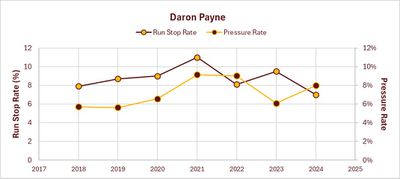
Daron Payne has been the team’s best interior run defender throughout his time in Washington. 2024 was the worst year of his career in terms of Run Stop Rate. Even so, he led the starting iDL in Run Stop Rate, and was second among all iDL, after NT Carl Davis Jr. His 7.0% Run Stop Rate placed him in the top half of starting iDL, and ranked 46th among 153 players with at least 76 run defense snaps.
Payne peaked at 10th among iDL in 2021, with a Run Stop Rate of 11.0%. Payne has suffered from high missed tackle rates throughout most of his career, and hit a new high (low?) in 2024. He has been over 17% since 2021.
Payne has seldom been as good at rushing the passer as he is at stopping the run. The big exception was his contract year in 2022, when he logged 11.5 sacks. His 2024 Pressure Rate of 8.0% ranked 46th among iDL, exactly the same as his run stop rank.
Payne was the primary starter on the left side of the interior defensive line and spent considerable time lined up at LDE, mainly at 5-technique. His alignment corresponded to the stronger side of the defensive interior in run defense.
The fall off in run defense in 2024 is a little concerning, but Payne is still fairly young. Whether or not he can bounce back to something closer to his early career form is one of the biggest questions on the Commanders’ defense.
RDT Jonathan Allen | 6’ 3” | 300 lbs | RAS 7.74
Age: 30 | Exp: 9 yrs | 2025 cap: $6.4M Vikings (dead cap $23.2 M)
2024 Stats: 8 starts | 421 def snaps | 21 tkl/2 asst | 18 stops | 4 TFL | 11.5% miss | 26 press | 3 sk
2024 Run Stop Rate: 6.6%, Rank: 62/153 | Pressure Rate: 10.4%, Rank: 22/120
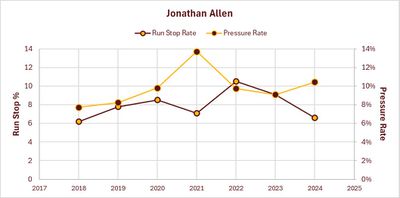
Allen was allowed to walk in free agency, following a disappointing, injury shortened season.
He is considerably lighter than Payne, and has generally been the better pass rusher of the two. But he has usually been a little weaker in run defense. 2024 was the second worst year of his career as a run stopper, regressing all the way back to where he was in his sophomore campaign in 2018. Even so, he was still the third best of the Commanders’ iDL group, with a Run Stop Rate of 6.6%. That placed him just above median for NFL starters, and ranked 62nd among 153 players who logged at least 76 run defense snaps.
As usual, Allen was better at rushing the passer. While his totals were down, due to missed time, when he was on the field he put pressure on QBs. His 10.4% Pressure Rate placed him just outside the top 25% of starting iDL, and ranked 22nd out of 120 iDL.
Allen was slated to be the primary starter at right DT, which corresponded to the weaker side of the interior DL in run defense. As a result of injury, he ended up sharing that responsibility nearly equally with rookie, Johnny Newton (358 snaps at RDT + RE vs 332 snaps for Newton).
RDT Jer’Zhan “Johnny” Newton | 6’ 2” | 295 lbs | RAS 7.73
Age: 22 | Exp: 1 yr | 2025 cap: $2.2M
2024 Stats: 11 starts | 586 def snaps | 31 tkl/17 asst | 20 stops | 6 TFL | 1 FF | 5.9% miss | 23 press | 2 sk | 1 PD
2024 Run Stop Rate: 5.3%, Rank: 102/153 | Pressure Rate: 7.8%, Rank: 51/120
The Commanders raised eyebrows by drafting Newton 36th overall, prompting talk about how much he would see the field as a rookie. His first offseason was interrupted by foot surgery, but he was able to start the season on the active roster. Jonathan Allen’s injury in Week 6 gave him the opportunity to take over as the primary starting right DT.
Newton finished the season with the second most defensive snaps of the Commanders’ iDL group, and the third most snaps of rookie DTs. He logged the third most defensive stops and second most pressures in the DT draft class and tied for fourth most sacks.
Newton didn’t come out of the gate on fire, but his Run Stop and Pressure Rates were not too different from Jonathan Allen’s sophomore season numbers in 2018 (Allen was injured in Week 5 of his rookie season and didn’t play enough snaps to post reportable stats). As Allen’s and Payne’s graphs illustrate, it is common for DT’s productivity figures to ramp up through their first few seasons in the league.
Newton’s 5.3% Run Stop Rate was the lowest on the Commanders iDL. It ranked 102nd out of 153 qualifying iDL, and placed him right at the bottom quartile mark of starting iDL. Newton was a quality run defender in college, and peaked with the 15th highest Run Stop Rate (10.2%) among Power 5 iDL in 2022. Hopefully another year of NFL coaching and conditioning will see him improve in 2025.
Newton was comparatively better at rushing the passer than stopping the run. His 7.8% Pressure Rate was slightly below Daron Payne, and ranked 51st among 120 qualifying iDL. That placed him just below median for NFL starters.
It was not a bad start for a rookie whose offseason preparation was interrupted by rehab from surgery.
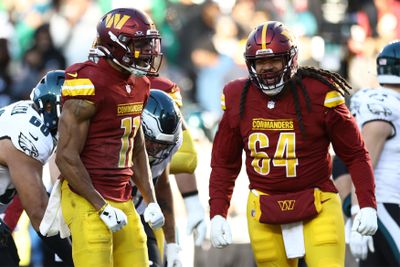
Photo by Timothy Nwachukwu/Getty Images
How Did the Commanders iDL Stack Up? – Rotational Players
The defensive line is different from many other position groups in that there aren’t really starters and backups so much as high rotation and low rotation players. The Commanders’ “backups” saw playing times in every game, and a few got substantial playing time. If you are wondering where Jalyn Holmes is, he will appear in the next article with the DEs because that’s where he took over 80% of his snaps.
LDT Sheldon Day | 6’ 1” | 285 lbs | RAS 6.06
Age: 31 | Exp: 9 yr | 2025 cap: $1.01M
2024 Stats: 0 starts | 339 def snaps | 17 tkl/9 asst | 10 stops | 2 TFL | 3.7% miss | 7 press
2024 Run Stop Rate: 6.1%, Rank: 81/153 | Pressure Rate: 4.0%, Rank: 106/120
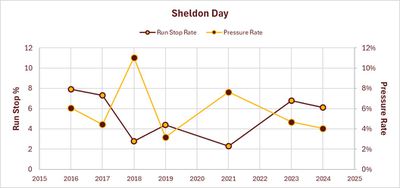
Day is an undersized journeyman iDT who spent time with 5 teams in 7 seasons before coming to Washington, and only started four games in his career. Day played in 15 games for the Commanders, rotating in predominantly at left DT.
Day has had his ups and downs in limited playing time throughout his career. In 2023, with the Vikings, and 2024 with the Commanders, he was better in run defense than the pass rush. But he wasn’t that great in either category.
Day’s 2024 Run Stop Rate, ranked 81st among qualifying iDL, and was below median for NFL starters. He was essentially a non-factor in the pass rush. The pattern was essentially opposite to what you’d expect from an undersized iDL.
NT Carl Davis Jr | 6’ 5” | 320 lbs | RAS 8.7
Age: 33 | Exp: 9 yr | 2025 cap: $1.03M
2024 Stats: 0 starts | 89 def snaps | 6 tkl/3 asst | 4 stops | 0.0% miss | 1 press
2024 Run Stop Rate: (8.9%), Rank: unranked | Pressure Rate: DNQ
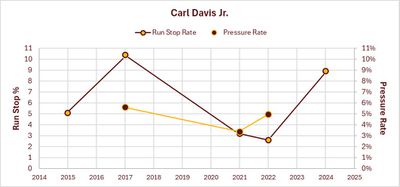
Carl Davis Jr was midseason signing, and played four games for the Commanders late in the season, almost exclusively over center or at 3-technique on the right guard.
Davis was drafted in the third round in 2015 by the Ravens. His early career was impacted by injury and he has bounced around the league since being released by the Ravens in 2018.
Davis peaked as a run defender when he was healthy in 2017, posting a very respectable 10.4% Run Stop Rate. He has not played enough snaps in most seasons since then to post reportable stats. He only played 48 run defense snaps in 2024, which is just below criterion. But it was close enough that I went ahead and include the data in the graph. His 8.9% Run Stop Rate would have been good for a starter, falling in the top 25% of the position group. That should be taken with a grain of salt, because of the limited snap counts. But, if he can replicate that performance through more playing time, he could be an asset in run defense.
Davis didn’t log enough pass rush snaps to post reportable stats.
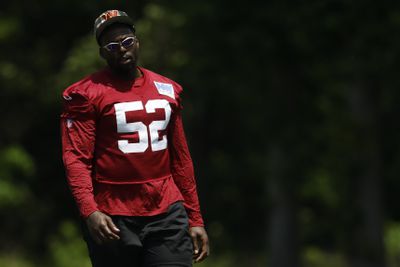
Geoff Burke-Imagn Images
How Did the Commanders iDL Stack Up? – New Additions
DT Javon Kinlaw | 6’ 5” | 319 lbs
Age: 27 | Exp: 6 yrs | 2025 contract: 3 years, $15M APY
2024 Stats: 17 starts | 695 def snaps | 27 tkl/7 asst | 24 stops | 5 TFL | 2 FF | 15.0% miss | 30 press | 5 sk
2024 Run Stop Rate: 6.4%, Rank: 72/153 | Pressure Rate: 7.5%, Rank: 53/120
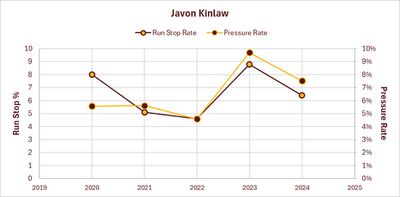
Javon Kinlaw was the Commanders’ biggest signing this offseason, literally and figuratively. Kinlaw replacing Jon Allen adds nearly 20 lbs to the Commanders’ defensive front. At $15M APY, his contract makes him the 22nd highest paid iDL in the league. Even so, the contract was widely panned as an overpay, because he is viewed as not having lived up to his draft status, after being picked 14th overall by the 49ers in 2020.
Kinlaw’s role on the DL has evolved over five NFL seasons. The 49ers played him predominantly as a 3-tech DT for his first three seasons, with very modest results. In 2023, they moved him out to DE on around 20% of snaps, and his productivity spiked in both phases.
With the Jets in 2024, Kinlaw split time nearly equally between DT and DE and posted fairly average numbers. His 6.4% Run Stop Rate was a little lower than the Commanders’ underperforming vet starters. It ranked 72nd of 153 qualifying iDLs, and placed him a little below median for a starter.
In the pass rush, Kinlaw’s 7.5% Pressure Rate was well below Jonathan Allen (10.4%), and also lagged Daron Payne (8.0%) and Johnny Newton (7.8%). Kinlaw ranked 53rd of 120 qualifying iDL, and was below median for a starter.
Kinlaw presumably replaces Jon Allen at RDT. Throughout his career, he has never matched Allen’s Run Stop Rate numbers, and only bested him as a pass rusher in 2023, which was a down year for the former Commander.
The Commanders know what they are getting in Kinlaw, since he was drafted when Adam Peters was the 49ers’ VP of Player Personnel, and was coached by Darryl Tapp. They seem to have big plans for how to use him. It will be interesting to see if Joe Whitt’s scheme can finally unlock his potential, which no one in San Francisco or New York could do.
NT Eddie Goldman | 6’ 3” | 332 lbs | RAS 1.99
Age: 31 | Exp: 7 seasons/10 yrs | 2025 contract: 1 yr, $1.03M
2024 Stats: 10 starts | 330 def snaps | 8 tkl/10 asst | 6 stops | 1 TFL | 25.0% miss | 10 press | 1 sk
2024 Run Stop Rate: 2.8%, Rank: 145/153 | Pressure Rate: 6.7%, Rank: 66/120
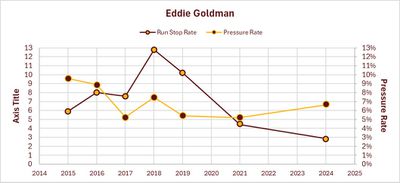
Goldman was signed in FA to a cheap one-year deal, presumably to compete with Carl Davis Jr. for the NT role in the DL rotation. Goldman was originally drafted in the second round by the Bears in 2015, and has had an up and down career trajectory.
Goldman peaked as an elite run stopper in 2018, with a 12.8% Run Stop Rate (5th in NFL). Then he took the 2020 COVID season off and retired from football from 2022 to 2023. He came out of retirement in 2024 and posted a career low Run Stop Rate of 2.8%, which ranked near the bottom of the league. He was better in the pass rush, but his Pressure Rate was still below median for starters.
It would appear that Goldman’s best football is behind him.
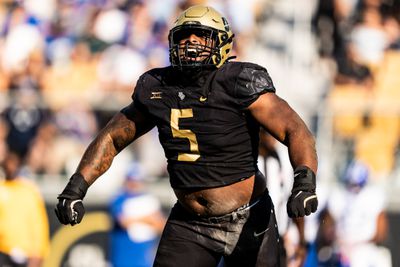
Photo by Conor Kvatek/UCF Athletics/University Images via Getty Images
How Might They Stack Up? – UDFAs
Also vying for roster spots in camp will be 2024 UDFA Norell Pollard and 2025 UDFA Ricky Barber. All we have to go on with these players is college stats, which don’t necessarily translate to the NFL. But they’re better than nothing.
DT Norell Pollard | 6’ 1” | 260 lbs | RAS 7.61
Age: 25 | 2025 cap: $842K
2023 College Stats: 13 games | 445 def snaps | 12 tkl/7 asst | 11 stops | 8 TFL | 20.8% miss | 30 press | 3 sk
2024 Run Stop Rate: 3.8%, Rank: 221/287 Power Five | Pressure Rate: 12.8%
Pollard was an undersized interior pass rusher who played five seasons for the VA Tech Hokies. He was a 2024 UDFA with Washington in 2024 and spent the season on IR.
Pollard’s productivity in the pass rush ramped up in his final two college seasons. I can’t be bothered doing the Pressure Rate rankings for NCAA football, but 12.8% is pretty good for an interior rusher.
He was essentially a non-factor against the run throughout his college career. His Run Stop Rate peaked in 2020 at 5.9%. But the 2024 number was more typical of his college stats. Pollard’s best chance to earn a spot on the final 53 man roster would be as an interior pass rush specialist – if that’s something the Commanders think they need. It will be an uphill battle.
DT Ricky Barber | 6’ 3” | 295 lbs | RAS 4.85
Age: 24 | 2025 cap: $845K
2023 College Stats: 12 games | 551 def snaps | 21 tkl/10 asst | 17 stops | 6 TFL | 6.1% miss | 26 press | 3 sk
2024 Run Stop Rate: 6.1%, Rank: 123/267 | Pressure Rate: 8.2%
Barber spent six years in college, starting at Western Kentucky and then transferring to UCF for his final four seasons. He had moderate production throughout his career, playing predominantly as a 3-tech DT.
He profiles as being very strong against the run, and received good to very good PFF run defense grades, throughout his college career, but that didn’t necessarily always translate to eye-popping Run Stop Rates. He peaked at 45th in the Power Five in 2021, with a Run Stop Rate of 8.2%. In 2024, his 6.1% Run Stop Rate was near the middle of the pack among Power Five IDL.
In the pass rush, Barber peaked in 2022, with a Pressure Rate of 10.3%, while recording 39 pressures, 3 sacks and 4 PD. In 2024, he recorded a decent 8.2% pressure rate for an 3-tech.
Barber might have been better off entering the draft earlier than waiting to his sixth year.
Barber is a somewhat similar size to Jonathan Allen entering the league, but less athletic and less accomplished. His best shot to earn a spot on the 53 man roster is battling for Sheldon Day’s spot at backup DT. That will be a challenge.
TLDR/Conclusions
The Commanders’ biggest weakness in 2024 was run defense. The previous two articles point to a glaring weakness at Right DE, which we’ll get to in the next article.
Run defense on the interior gaps ranged from weak to mediocre. The left interior, where Daron Payne is the primary starter, was stronger than the right interior, where Jonathan Allen and Johnny Newton split starting reps.
Results in this article confirmed that, despite posting career low figures, Daron Payne was the Commanders’ strongest starting iDL in run defense. Only rotational NT Carl Davis Jr posted a higher Run Stop Rate, in limited snaps. Jonathan Allen was the only other iDL with a Run Stop Rate above median for NFL starters. Rookie Johnny Newton performed around the bottom quartile for starting iDL.
This article also examined pass rush performance, as quantified by Pressure Rate. Jonathan Allen led the starting iDL in pressuring the QB, as he has done for much of his time in Washington. Daron Payne was next best, and Johnny Newton did well for a rookie, despite the slow start to his season.
Javon Kinlaw was signed in free agency to replace Jonathan. Allen’s Run Stop Rate was slightly better than Kinlaw’s last season, despite the fact that it was Allen’s lowest figure since 2018. Kinlaw was a little better run stopper than Newton. Kinlaw’s Pressure Rate in the pass rush was lower than Allen’s and Newton’s last season. Kinlaw has only surpassed Allen in the pass rush once, during his peak season in 2023, which was Allen’s worst season since 2019.
The best hope for improved performance from the iDL this season would seem to lie with Daron Payne bouncing back from a career low season in run defense, and 22 year old Johnny Newton taking a developmental step in his second season.
It is possible that role and scheme adjustments could unlock Javon Kinlaw’s latent potential, providing a boost to the defensive front. But there is nothing about his previous performance to suggest that he will be a significant improvement over last year’s starting RDTs. He might even be a downgrade. The biggest things in his favor are that he is bigger and younger than Allen, who is probably entering the downward slope of his career.
None of the other iDL additions seem likely to make an impact this season.
